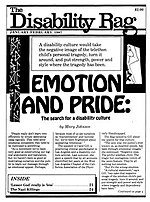The Disability Rag
[1] After a few years The Rag began to get national attention due to the efforts of Irvin, who was active in the American Coalition of Citizens with Disabilities (ACCD).
The Disability Rag's national growth was accelerated in 1985 by a front page Wall Street Journal article.
[3] The Rag was a hybrid: both a news magazine, with coverage of emerging activism local and nationwide, and an opinion journal.
The Rag covered the full range of disability political issues from charity telethons to physician assisted suicide to protests over inaccessible public transit.
When ADAPT started a national activist effort to change public transit policy, The Rag provided continuing coverage of the activists and the issue, and the coverage was collected and published as To Ride the Public's Buses: The Fight that Built A Movement, The Advocado Press's first "Disability Rag Reader."
[4] It urged readers to view themselves not as victims of tragedy but survivors facing discrimination and barriers, which could be removed by society.
The Wall Street Journal told readers about the "wheelchair-riding rodent who, irked at having his handicapped-parking space swiped, blows up the offending vehicle."
"[7] Bob Ruffner, then the director of public affairs for the President's Committee on Employment of People with Disabilities, called The Rag "a strong voice for those who may not be associated with a lot of well-organized groups.
Some felt its "strident, shoot from the hip approach" was counterproductive; that its accusatory tone diminished the impact of its message.
The fact that The Rag celebrated disability to the extent that it frequently took stances against charity appeals for cures, such as telethons, rubbed critics the wrong way.
Fundraising efforts by its nonprofit Advocado Press starting in the mid-1980s resulted in a number of financial gifts both from longtime members and various progressive and activist groups.


